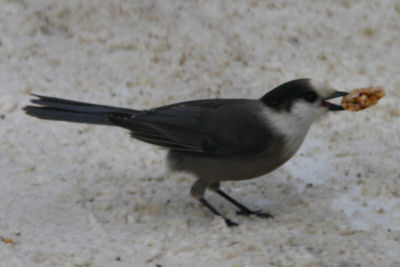The Adirondack Mountains have long fascinated me. There are some seriously deep woods up there where bears roam and people are scarce. Winters are harsh with below zero temperatures the norm rather than the exception and snow that may not melt until May. This winter is even more interesting than most for the amateur ornithologist because of the invasion of the crossbills.
Crossbills are finches with impossible-looking bills that cross over themselves, making them look like they’ve been roosting too close to a cooling tower. Their bills, however, are perfect for extracting seeds from the cones of a variety of evergreens. Because of these fancy beaks they are perfectly adapted to winter life in evergreen forests, where cones are one of the few food options. The disadvantage of such a specialized diet is that crossbills must go to where the cones are…fortunately, most of New York has had a bumper cone crop this year.
Having heard reports of crossbills galore since late last fall I figured it was time to finally make an attempt to familiarize myself with these funny finches (ok, ok, I’ve tried before and even had poor looks at Red Crossbills once, but nothing to write home about). So I picked up my friend and fellow birder, Will, at 6 am (on a Saturday, no less) and we made tracks up the Northway and deep into the cold, snow-covered mountains.
En route we saw the usual highway-side Red-tailed Hawks and American Crows. As we got further north and higher in elevation Common Ravens began to replace the crows. Finally, after a brief stop at a Stewart’s (expect a post on this upstate institution sometime soon) for breakfast sandwiches we were in prime habitat and ready for some good birds.
Driving back roads in the Adirondacks in winter is interesting, to say the least. The snow isn’t so much removed as it is packed down and covered with a layer of dirt. This forces drivers to slow down, which is good for the birders. At our slow pace with the windows cracked open we could hear birds more often than we could see them. At the first sign of avian activity we stopped the car and rustled up a bunch of Black-capped Chickadees and a couple Red-breasted Nuthatches.
Our next stop, about a half-mile up the road, yielded two Boreal Chickadees, the northern version of the Black-capped. I had only heard a Boreal Chickadee previously so seeing two was a big treat. They should be called Boreal Sickadays though, as they clearly do not say “chick-a-dee-dee.”
Bigelow Road, an unpaved, unplowed route through a magnificent spruce forest was our next stop. We walked with difficulty on snowmobile tracks on top of about three feet of snow. We could hear birds everywhere but didn’t see any until we arrived at a spacious clearing where crossbills were flying around the tippy-tops of some very tall spruces. We spished a bit and suddenly we were surrounded by a bird bonanza! Pine Siskins, chickadees, White-winged Crossbills, and nuthatches flew all around us. A male White-winged Crossbill almost landed on Will’s head! It was a wonderful way to add White-winged Crossbill to my life list. But we weren’t done yet!
We next drove up Oregon Plains Road through a more mixed forest, with spruces still dominating, but hardwoods and other evergreens present as well. Crossbills of both species were everywhere along with more Pine Siskins and Purple Finches. At one point males of both species of crossbill were sitting side by side at the top of a spruce.
Driving back down Oregon Plains Road we heard bird sounds so we stopped and I quickly hopped out, forgetting my binoculars. Reaching back into the car I heard Will say in the excited undertone any birder anywhere recognizes, “There are four Gray Jays behind you.”
As I grabbed my binoculars I also grabbed a granola bar because Gray Jays will often take a treat if offered. Sure enough, as soon as I tossed some chunks of granola on the ground one was on it, carrying it off into the woods to cache for later. We had a great time feeding and photographing the jays that truly earned the nickname “Camp Robber.”

We left the Adirondacks having seen or heard only sixteen species, but man were they good species. A lifer, and great looks at four species that I have rarely experienced. We weren’t done birding for the day…so look for a continuation of this saga tomorrow.













It sounds like a wonderful day. Your narrative reminds me of a trip to northern Minnesota during the Great Gray Owl invasion of 2004-05. We saw some of the same species you report (but missed crossbills), and as you said, though they weren’t many in number, they were really excellent birds. But I’m a long way from the frozen North now.